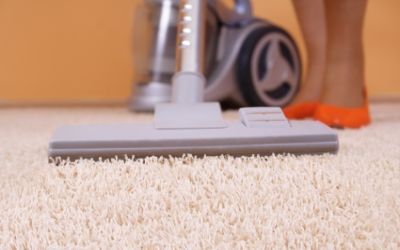UV Light Nearly Doubles Vacuum's Effectiveness in Reducing Carpet Microbes

New research suggests that the addition of ultraviolet light to the brushing and suction of a vacuum cleaner can almost double the removal of potentially infectious microorganisms from a carpet's surface when compared to vacuuming alone.
Researchers say the findings suggest that incorporating the germicidal properties of UV light into vacuuming might have promise in reducing allergens and pathogens from carpets, as well.
"What this tells us is there is a commercial vacuum with UV technology that's effective at reducing surface microbes. This has promise for public health, but we need more data," says Timothy Buckley, associate professor and chair of environmental health sciences at Ohio State University and senior author of the study. "Carpets are notorious as a source for exposure to a lot of bad stuff, including chemicals, allergens and microbes. We need tools that are effective and practical to reduce the associated public health risk. This vacuum technology appears to be a step in the right direction."
The research appears online in the journal Environmental Science & Technology.
For this study, Buckley and colleagues tested a commercially available upright vacuum cleaner, evaluating separately and in combination the standard beater-bar, or rotating brush, as well as a lamp that emits germicidal radiation.
UV-C light with a wavelength of 253.7 nanometers has been studied extensively for its disinfection properties in water, air and food and on a variety of surfaces. This is the first study of its effects on carpet surfaces.
The Ohio State research group selected multiple 3-by-3-foot sections of carpeting of different types from three settings: a commercial tight-loop carpet in a university conference room, and medium Berber carpet with longer, dense loops in a common room of an apartment complex and a single-family home.
Researchers collected samples from each carpet section using contact plates that were pressed onto the flooring to lift microbes from the carpet surfaces. They collected samples from various locations on each test site to obtain a representative sample of the species present on the carpets.
After sampling, the plates were incubated for 24 hours in a lab and the number of colonies was counted. The plates contained growth media particularly suited for fungi commonly found in indoor environments, including Penicillium and Zygomycetes.
Each treatment was tested separately by collecting multiple samples from each 3-by-3-foot section before and after treatment: vacuuming alone, the application of UV-C light alone, or a combination of UV-C light and vacuuming. In each case, the carpets were vacuumed at a speed of 1.8 feet per second for two minutes.
Overall, vacuuming alone reduced microbes by 78 percent, UV-C light alone produced a 60 percent reduction in microbes, and the combination of beater-bar vacuuming and UV-C light reduced microbes on the carpet surfaces by 87 percent. When looking at the microbe quantities, the researchers found that, on average, vacuuming alone removed 7.3 colony-forming units of microbes per contact plate and the UV-C light removed 6.6 colony-forming units per plate. The combination of UV-C light and vacuuming yielded the largest reduction in colony-forming units: 13 per plate.
"We concluded that the combined UV-C-equipped vacuum produced approximately the sum of the individual effects, and therefore the UV-C was responsible for an approximate doubling of the vacuum cleaner's effectiveness in reducing the surface-bound microbial load," Buckley said.
Surfaces in residential settings, and especially carpets, are seen as potentially posing health risks because they are reservoirs for the accumulation of a variety of contaminants. Those most susceptible to infection, including the elderly, asthmatics, the very young and people with compromised immune systems, might be at particular risk because they spend most of their time indoors, Buckley noted.
"The best next step would be to test this UV-C vacuum technology in some environments that are high risk, where we could sample for specific pathogens," Buckley said. "The home environment would be particularly important, because that's where people spend the lion's share of their time and are likely to be in close contact with carpet."
Most natural UV-C rays from the sun are absorbed in the atmosphere, but long-term exposure to artificial UV-C sources can cause skin and eye damage. The vacuum has been engineered to prevent exposure to harmful radiation from the UV-C lamp, Buckley said.
Upright vacuum retail prices generally range from about $100 to $900. The equipment in this study falls within that range.
This work was supported through a contract with Halo Technologies Inc. of Des Plaines, Ill., which supplied the vacuum technology.
Co-authors of the study include Eric Lutz, Smita Sharma and Bruce Casto of the Division of Environmental Health Sciences and Glen Needham of the Department of Entomology, all at Ohio State.
Vet IP Roundtable 2: Infection Control and Biosecurity Challenges in Veterinary Care
March 31st 2025Veterinary IPs highlight critical gaps in cleaning protocols, training, and biosecurity, stressing the urgent need for standardized, animal-specific infection prevention practices across diverse care settings.
Invisible, Indispensable: The Vital Role of AHRQ in Infection Prevention
March 25th 2025With health care systems under strain and infection preventionists being laid off nationwide, a little-known federal agency stands as a last line of defense against preventable patient harm. Yet the Agency for Healthcare Research and Quality (AHRQ) is now facing devastating cuts—threatening decades of progress in patient safety.
From Shortages to Security: How Reusable Health Care Textiles Can Transform Infection Prevention
March 7th 2025Reusable health care textiles enhance infection prevention, reduce waste, and strengthen supply chains. Hygienically clean textiles offer a sustainable, cost-effective alternative to disposable PPE, ensuring patient safety and environmental responsibility.